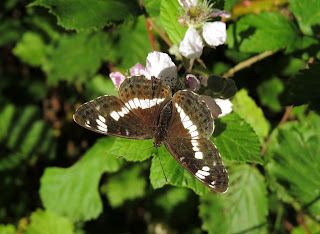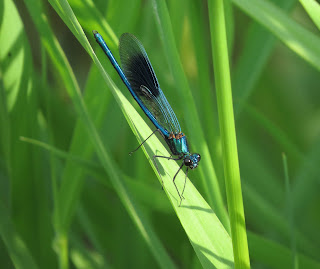The butterflies in particular, are a big draw for me, with a fab variety of common and rarer species too and I've now recorded 26 species (and counting) in total here. This year has been great, however I just wished I could've spent more time here exploring!
There have been a handful of major highlights in Bucknell for me this year. The first was the discovery of only the second ever White-Letter Hairstreak for the site. Somewhat fortuitously, it landed right in front of me, began nectaring on a bramble flower for a short while, before shooting back up to the treetops!
Since then Doug Goddard, the Northants Butterfly recorder managed to find another in a different part of the wood. Checking this area last Saturday (25/07) I managed to see 1, possibly 2 in the oaks above the brambles where Doug had seen his. So it appears there maybe more here than first thought!
Since then Doug Goddard, the Northants Butterfly recorder managed to find another in a different part of the wood. Checking this area last Saturday (25/07) I managed to see 1, possibly 2 in the oaks above the brambles where Doug had seen his. So it appears there maybe more here than first thought!
Another main highlight is the continued occurrence of Valezina Silver-Washed Fritillaries. These are a rare form of female Silver-Washed. Last year I managed to find one rather mobile specimen, however this year I've managed to see 2 possibly 3 individuals, getting some far better photos too! They are stunning creatures, looking rather metalic! They're behaviour too appears to be slightly different, often sticking to more shady areas of the wood.
Thankfully, the wood is clinging onto a tiny population of Purple Emperors, however it appears the rather reckless tree felling the Forestry Commission have carried out over the winter and early spring may well have affected numbers. The good news is there have been a couple of sightings. I personally had a particularly brief view of one zooming along the treetops back on 19/07, while someone else not known to me had rather better views of one, gaining some good photographs earlier on in the month apparently. In the absence of any pics from me this year here's a couple taken in Bucknell last year!
The site has become a great place for Silver-Washed Fritillaries and this year has been no exception. Visiting early last Saturday (25/07) morning, there were easily around 30 and that was just in the eastern part of the wood!
Purple Hairstreaks appear to be in reasonable numbers, though getting a decent look at one without the use of binoculars is rare! Luckily for me, one did come down reasonably close on 19/07.
White Admirals don't appear to be in quite the numbers they were in last year but there have still been a fair amount knocking about.
The continued presence of the tiny colony of Essex Skippers continues to hang on with maximum of 3 seen at any one time, together with several Small Skippers. The Large Skippers in Bucknell appear to be in rude health, as do the Ringlets & Meadow Browns. I also had my first couple of Painted Lady in Bucknell, as part of the mid-summer influx into the country.
On the bird front, the place is alive with young birds mainly tits, Goldcrests & warblers. There's has also been a couple of Siskin sightings, as part of a recent influx from the continent after a particularly good breeding season. The odd Spotted Flycatcher as also been on show, but on the whole they have been very elusive.






















































